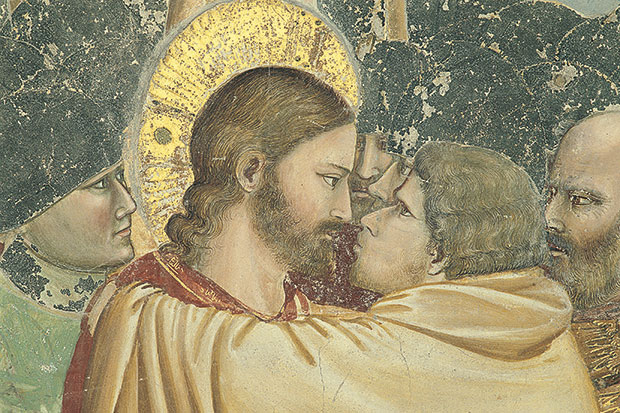Peter Stanford is a writer on religious and ethical matters. He was for four years editor of the Catholic Herald. Writing Judas: The Troubling History of the Renegade Apostle must have been a difficult task because there are no facts. Judas may quite possibly never have existed at all, and if he did, the Judas kiss may not have happened. Also, he may not have hanged himself. This is a fascinating story of febrile myth-making over two millennia, with very little historical fact.
Stanford starts his pursuit of Judas with a visit to gloomy Hakeldama in Jerusalem, the place where Judas is traditionally said to have hanged himself — if he did hang himself. The famous kiss is, as Stanford points out, improbable because those who were looking for Jesus in the garden of Gethsemane would have known perfectly well who he was in a group of 12; after all, he had recently created havoc among the moneylenders of the temple. The story of the Judas kiss was the start of the notion of betrayal and Stanford suggests that he was a necessary scapegoat. Judas was reviled by the evangelists: Mark labelled him the betrayer, in John’s Gospel he is described as the ‘son of perdition’ and according to Luke the devil entered him.
Stanford moves on from the speculative and the unsubstantiated to an account of how Christianity treated the story of Judas over the next 2,000 years. St Jerome (347–420), translator of the Vulgate, proclaimed that ‘in Judas the Jews may be accursed’. Ominously, the words ‘Judas’ and ‘Jew’ were conflated.
In search of Judas and his ever-changing image, Stanford visits many early churches and monasteries to uncover the fascination aroused by Judas. In the stunning sculpture of the last supper in Volterra, Judas is portrayed as half beast, crawling beneath the table. Stanford reminds us that Shakespeare compares Orlando’s red hair to Judas’s red hair, calling it ‘the dissembling colour’. He also tells us that Dante reserved the last circle of hell for betrayers, in a place called Giudecca, named after Judas. The link between Jews and betrayal continued to be made as late as the Dreyfus affair and of course on to the ultimate horror. In a more domestic setting, Stanford visits a church in Dorset to look at the wonderful stained-glass windows of Laurence Whistler. The squeamish congregation would not allow the final image, of Judas hanged, in the church. Many years later, the window can be seen in a blind arch, but only from the outside.
Judas has had a prolonged life, made real and vivid in literature, in religious teaching, in Biblical history, in art and even in films: Bob Dylan described Judas as ‘the most hated name in human history’. The fascination with Judas has persisted, despite the fact that there is no evidence of the hard facts of his life. Even the ‘Iscariot’ attached to him may be nothing more significant than a corruption of the name of the town from which he came.
Stanford’s book is ultimately a cultural history of the forces which subsumed Judas, leading unstoppably to the version of him — so close to ‘Jew’ or ‘Yehuda’ — that lent weight to the idea that the Jews were the murderers of Christ. Anti-Semitism has become particularly widespread again, stirring memories of the Holocaust. The persistent idea that Jews are the cause of much that is toxic in this world is so absurd, so irrational — particularly in the minds of many Muslims — that this book provides, among many insights, a timely account of the origins of anti-Semitism. It is uncomfortable to be reminded that the Catholic church only removed the reference to ‘perfidious Jews’ from the Good Friday liturgy in 1960.
It is striking that the lives of Jesus and Judas overlapped for a few years with the life of Herod the Great. Geza Vermes, who died in 2013, was the first professor of Jewish studies at Oxford, and his last book was The True Herod (Bloomsbury, £20, Spectator Bookshop, £18). In writing it Vermes was equipped with a lifetime of biblical knowledge, including a wealth of material about Herod and his family. Josephus, himself a hellenised Jew, provided detailed accounts of Herod’s life. What we learn is that almost nothing we believed about Herod is true: that he was only half-Jewish and often disliked by his subjects; that he clung tenaciously to the Romans for his survival; that Salome was not the cause of John the Baptist’s death (Herod had him killed because he was concerned about John’s growing popularity in Judaea). He had his own wife and his sons murdered, and for years afterwards these acts tormented him. But one of the most surprising facts about him was his passion for building. There are astonishing remains of his temple, including the Wailing Wall, Herodium and the harbour at Caesarea. It is a gripping and scholarly work. Both these books throw light on our deep history.
Available from the Spectator Bookshop, £16 Tel: 08430 600033






Comments